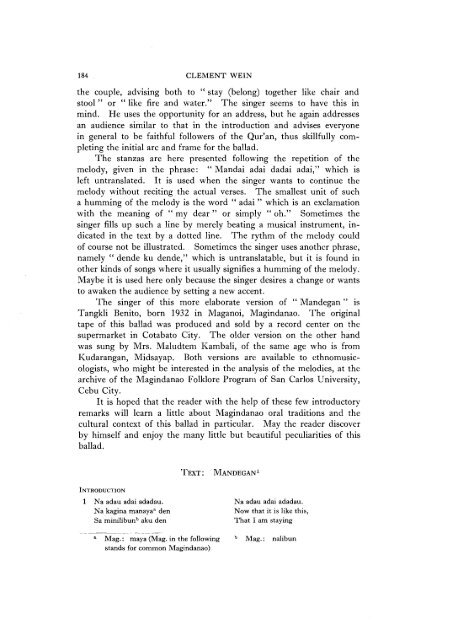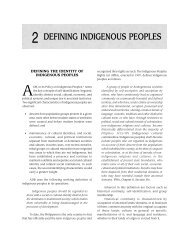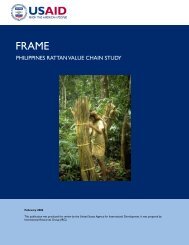You also want an ePaper? Increase the reach of your titles
YUMPU automatically turns print PDFs into web optimized ePapers that Google loves.
184 CLEMENT WEINthe couple, advising both to " stay (belong) together like chair andstool " or " like fire and water." The singer seems to have this inmind. He uses the opportunity for an address, but he again addressesan audience similar to that in the introduction and advises everyonein general to be faithful followers of the Qur'an, thus skillfully completingthe initial arc and frame for the ballad.The stanzas are here presented following the repetition of themelody, given in the phrase: " Mandai adai dadai adai," which isleft untranslated. It is used when the singer wants to continue themelody without reciting the actual verses. The smallest unit of sucha humming of the melody is the word " adai " which is an exclamationwith the meaning of " my dear " or simply " oh." Sometimes thesinger fills up such a line by merely beating a musical instrument, indicatedin the text by a dotted line. The rythm of the melody couldof course not be illustrated. Sometimes the singer uses another phrase,namely " dende ku dende," which is untranslatable, but it is found inother kinds of songs where it usually signifies a humming of the melody.Maybe it is used here only because the singer desires a change or wantsto awaken the audience by setting a new accent.The singer of this more elaborate version of " <strong>Mandegan</strong> " isTangkli Benito, born 1932 in Maganoi, Magindanao. The originaltape of this ballad was produced and sold by a record center on thesupermarket in Cotabato City. The older version on the other handwas sung by Mrs. Maludtem Kambali, of the same age who is fromKudarangan, Midsayap. Both versions are available to ethnomusicologists,who might be interested in the analysis of the melodies, at thearchive of the Magindanao Folklore Program of San Carlos University,Cebu City.It is hoped that the reader with the help of these few introductoryremarks will learn a little about Magindanao oral traditions and thecultural context of this ballad in particular. May the reader discoverby himself and enjoy the many little but beautiful peculiarities of thisballad.1 Na adau adai adadau.Na kagina manayaa denSa minilibunb aku denNa adau adai adadau.Now that it is like this,That I am staying- - - -a Mag. : maya (Mag. ln the following Mag. : nallbunstands for common Magindanao)
















